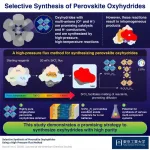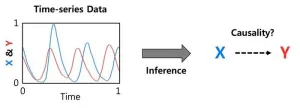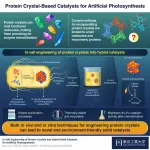(Press-News.org) A molecular imaging tool developed by researchers at the University of California’s two nationally ranked medical centers, UCLA and UCSF, helps improve the accuracy of predicting the risk of cancer recurrence in patients with intermediate to high-risk prostate cancer who undergo surgery.
The tool, known as prostate-specific membrane antigen PET imaging, or PSMA PET, provides prognostic information before treatment begins that can predict if the patient will have a high risk for the cancer returning after surgery.
“In patients with prostate cancer considered for surgery, PSMA PET can provide information on the risk of recurrence after surgery, before the surgery even happens,” said Dr. Loic Djaileb, a visiting associate professor at the David Geffen School of Medicine at UCLA and the study’s first author. “The imaging tool improves personalized treatments by helping the urologist decide whether or not to perform surgery, and to guide the surgical plan and the follow-up management after surgery.”
The findings are described in European Urology and were presented at the American Society of Clinical Oncology and Society of Nuclear Medicine & Molecular Imaging annual meetings in 2022.
Assessing the risk of prostate cancer recurrence after a radical prostatectomy—the surgical removal of the whole prostate gland to remove the cancer—is crucial in clinical practice to determine the appropriate treatment for each patient.
There are currently tools that can help characterize the disease before surgery, such as the CAPRA (Cancer of the Prostate Risk Assessment) score, which combines PSA, MRI and biopsy information. However, the information needed to fully understand the depth of the disease is based on analysis of tissue from the resected prostate and pelvic lymph nodes, which is obtained only after surgery (CAPRA-Surgery score: CAPRA-S).
“Urologists need to assess the chance of success of the surgery in a patient with prostate cancer before the surgery in order to create the most effective treatment plans for patients,” said co-senior author Dr. Jeremie Calais, an associate professor and director of the Clinical Research Program of the Ahmanson Translational Theranostics Division in the Department of Molecular and Medical Pharmacology at UCLA and member of the UCLA Jonsson Comprehensive Cancer Center.
To determine if PSMA PET could improve risk stratification and add value to current tools for determining cancer recurrence before surgery, investigators assessed 240 patients who had PSMA PET prior to surgery.
Each scan was read by three blinded independent readers. PSMA PET and CAPRA scores were then used to assess risk of a biochemical recurrence, which is the reappearance of certain indicators of prostate cancer in the blood (PSA: Prostate Specific Antigen). This occurs in 20-50% of patients within 10 years after surgery. Early biochemical recurrence—happening within three years after surgery—is associated with a poor prognosis and increased cancer-specific mortality.
The study found that the risk assessment obtained by combining pre-surgical CAPRA score and PSMA-PET was similar to the risk assessment obtained by using the post-surgical CAPRA-S score that relied on tissue collected during surgery. This suggests that PSMA-PET can be a strong predictive biomarker when histological data from surgery are not available.
“The addition of PSMA PET to the pre-surgical CAPRA score significantly improved the risk assessment for biochemical recurrence in comparison to the pre-surgical CAPRA score alone,” Djaileb said.
“PSMA PET is now the best imaging tool for prostate cancer,” said Dr. Thomas Hope, a professor at UCSF and co-senior author of the study. “As it is still new, we need to learn how to use the information derived from PSMA PET for the best outcomes of patients.”
Further prospective studies with pre-surgical PSMA-PET staging and with longer follow-up periods are needed to confirm the findings and evaluate the impact of PSMA-PET on other outcomes such as metastasis occurrence and overall survival.
The research was supported in part by the Prostate Cancer Foundation, the National Cancer Institute (R01CA235741 and R01CA21248) and the Society of Nuclear Medicine and Molecular Imaging.
END
PSMA PET imaging improves accuracy of predicting prostate cancer recurrence
The addition of the molecular imaging test provides a better risk assessment for cancer recurrence compared to the current standard of care test
2023-07-25
ELSE PRESS RELEASES FROM THIS DATE:
All US racial and ethnic minority groups are underrepresented in Alzheimer’s neuroimaging research, study shows
2023-07-25
Alzheimer’s disease (AD), which affects an estimated 6.5 million adults in the United States, hits some groups harder than others. Compared to non-Hispanic whites, Hispanic Americans are 1.5 times as likely to develop AD, and African Americans are twice as likely.
But scientists know little about the reasons behind these disparities, because the vast majority of AD research has been done with non-Hispanic white people.
A new study that reviewed 11,871 research articles on AD brain imaging, led by researchers at the Keck School of Medicine of USC, has now revealed the extent of ...
84% cut in Covid deaths for UK cancer patients following vaccine rollout
2023-07-25
Cancer patients saw a significant fall in Covid-related hospitalisations and mortality following the rollout of vaccines in the first panoramic study of its kind.
The research published in Scientific Reports today (Tuesday 25 July) looked at the impact of the global pandemic on case-outcome rates for cancer patients across a 21-month period from November 2020 to August 2022. The team of researchers led by the University of Birmingham found that hospitalisations in the period fell from nearly one in three patients (30.58%) to one in 13 patients (7.45%); and, case-mortality rates fell from more than one in five patients (20.53%) to less than one in 30 patients (3.25%).
Among ...
A chance to design better vaccines?
2023-07-25
A new paper in Biology Methods & Protocols, published by Oxford University Press, shows it may be possible to design vaccines that will induce a stronger immune response to infecting pathogens, such as the virus causing COVID-19. In this study, the authors proposed and tested a new bioinformatic approach and tool that allows researchers to select parts of proteins that will elicit a strong immune response. Vaccines developed based on this approach would provide better protection from diseases.
The immune system of humans (and other vertebrates) discriminates between self and non-self structures to attack and destroy the latter. T cells are the part of the immune system ...
A high-pressure flux method to synthesize high-purity oxyhydrides
2023-07-25
Adding a flux during the synthesis of oxyhydrides is a promising strategy to obtain a pure, homogenous product, reveal scientists from Tokyo Tech. An SrCl2 flux promoted the melting of a part of reactants and facilitated their diffusion of reactants, which proved to be the key to producing highly pure SrVO2.4H0.6 or Sr3V2O6.2H0.8 perovskite oxyhydrides in high-pressure and high-temperature reactions. These compounds have potential as catalysts and as electrode materials for lithium-ion batteries.
Perovskite oxyhydrides ...
Multi-levitation bioprinting of heart models for space exploration and medicine
2023-07-25
As a bold venture at the forefront of biomedical research, the PULSE project is poised to develop paradigm-changing bioprinting technology for applications in space and on Earth. Awarded nearly 4 million euros by the European Innovation Council’s Pathfinder Open, PULSE emerges from interdisciplinary scientific collaborations and, over five years, will foster technological innovations to improve human health and pave the way for safer and more sustainable space exploration.
By combining magnetic and acoustic levitation into an innovative bioprinting platform, PULSE’s device should be capable of achieving unparalleled spatiotemporal control of cell deposition. ...
CHOP researchers validate pediatric “allergic march” in largest national study of its kind
2023-07-25
Philadelphia, July 25, 2023—In the largest study of its kind, researchers from Children’s Hospital of Philadelphia (CHOP) used electronic health record (EHR) data from more than 200,000 pediatric patients to describe patterns of pediatric allergies across the United States, validating a population-level pattern of allergy development known as the “allergic march,” in which allergies first present as eczema, followed by food allergies, asthma, and environmental allergies. The ...
Introducing GOBI: A breakthrough computational package for inferring causal interactions in complex systems
2023-07-25
In the quest to unravel the underlying mechanisms of natural systems, accurately identifying causal interactions is of paramount importance. Leveraging the advancements in time-series data collection through cutting-edge technologies, computational methods have emerged as powerful tools for inferring causality. However, existing model-free methods have struggled to differentiate between generalized synchrony* and causality, leading to false predictions. On the other hand, model-based methods, while accurate, have been limited by their dependence on specific models, hindering their widespread applicability.
*Synchrony ...
Towards artificial photosynthesis with engineering of protein crystals in bacteria
2023-07-25
In-cell engineering can be a powerful tool for synthesizing functional protein crystals with promising catalytic properties, show researchers at Tokyo Tech. Using genetically modified bacteria as an environmentally friendly synthesis platform, the researchers produced hybrid solid catalysts for artificial photosynthesis. These catalysts exhibit high activity, stability, and durability, highlighting the potential of the proposed innovative approach.
Protein crystals, like regular crystals, are well-ordered molecular structures with diverse properties and a huge potential for customization. They can assemble naturally from materials found within cells, which not only greatly reduces the synthesis ...
New study on sleep/circadian disturbance’s impact on multiple chronic pain disorders
2023-07-25
Can poor sleep and circadian rhythm make chronic pain conditions worse? Edson College Assistant Professor Chung Jung Mun plans to find out through an innovative longitudinal study.
Mun was awarded a $3 million grant from the National Institute of Neurological Disorders and Stroke, part of the U.S. National Institutes of Health, to explore the possible connection.
“There are countless individuals suffering from multiple chronic pain disorders. A person with chronic migraine headaches is also likely to suffer from chronic low back pain. What we’re trying to find ...
Knees up! Computational modeling could improve knee implant alignment
2023-07-25
A Texas A&M University doctoral student has collaborated with an innovative surgical navigation and robotics company on motion capture research that can potentially improve implant alignment during knee replacement surgeries.
Aaron Henry is a fourth-year Ph.D. student in the Doctor of Philosophy in Interdisciplinary Engineering program in the Department of Multidisciplinary Engineering. He worked with Caira Surgical, a surgical navigation and robotic orthopedic surgery company that focuses on simplifying workflows and developing technological ...
LAST 30 PRESS RELEASES:
iPS cells from dish to freezer and back
Deep neural networks enable accurate pricing of American options under stochastic volatility
Collective risk resonance in Chinese stock sectors uncovered through higher-order network analysis
Does CPU impact systemic risk contributions of Chinese sectors? Evidence from mixed frequency methods with asymmetric tail long memory
General intelligence framework to predict virus adaptation based on a genome language model
Antibiotic resistance is ancient, ecological, and deeply connected to human activity, new review shows
Vapes, pouches, heated tobacco, shisha, cigarettes: nicotine in all forms is toxic to the heart and blood vessels
From powder to planet: University of Modena engineers forge a low-carbon future for advanced metal manufacturing
Super strain-resistant superconductors
Pre-school health programme does not improve children’s diet or physical activity, prompting call for policy changes, study finds
Autumn clock change linked to reduction in certain health conditions
AI images of doctors can exaggerate and reinforce existing stereotypes
Where medicine meets melody – how lullabies help babies and parents in intensive care
We may never be able to tell if AI becomes conscious, argues philosopher
AI video translation shows promise but humans still hold the edge
Deep ocean earthquakes drive Southern Ocean’s massive phytoplankton blooms, study finds
Without campus leftovers to pick through, the beaks of this bird changed shape during the pandemic
High-dose antibiotic does not reduce mortality in tuberculous meningitis
How many insects fly in the sky above the USA?
Could cheese protect your brain health?
Who faces more difficulty recovering from stroke?
Colliding galaxies create the brightest, fastest growing black holes at their center
New BrainHealth research reveals tradeoffs on sleep with cannabis use for chronic pain
Aging-US now on ResearchGate, enhancing visibility for authors and readers
'Molecular glue' stabilizes protein that inhibits development of non-small cell lung cancer
Mount Sinai Health System is recognized in 2025 Chime Digital Health Most Wired survey
From prey to predator: How carnivores spread beneficial fungi
Menopause symptoms may be frequent and have negative effects, according to female endurance athletes
US Congressmembers’ responses on X to mass shooting events differ along party lines
KAIST-UEL team develops “origami” airless wheel to explore lunar caves
[Press-News.org] PSMA PET imaging improves accuracy of predicting prostate cancer recurrenceThe addition of the molecular imaging test provides a better risk assessment for cancer recurrence compared to the current standard of care test




